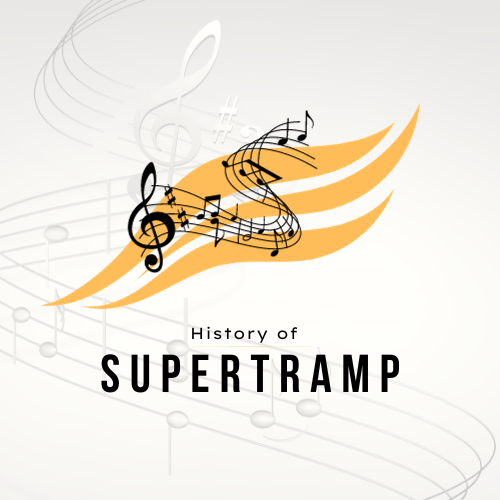The band’s early days, struggles and shifting personnel
Pianist and vocalist Rick Davies formed what would be the classic rock group Supertramp in 1969. Previously, he had played on another group The Joint, whose financial backer was a Dutch millionaire Stanley August Miesegaes. Miesegaes eventually had grown so disappointed with The Joint whom he eventually dropped. However, he still believed in Davies’ talent. Miesegaes offered Davies financial support if the latter would form a new band.
In response, Davies recruited new musicians: Richard Palmer (guitars), Robert Millar (drums/percussion) and Roger Hodgson (vocals/bass). Initially naming the band Daddy, the band then changed it to Supertramp to avoid confusion with the other groups sporting similar names.
Supertramp signed with A&M records in 1970 and released their self-titled debut album later that year. The album didn’t do well enough, and later Supertramp experienced lineup changes. Hodgson shifted from playing bass to guitar as Palmer and Millar left the group. New members Frank Farrell (bass), Kevin Currie (drums/percussion) and Dave Winthrop (flute/sax) joined the fold.
The newly revamped Supertramp issued their sophomore effort Indelibly Stampedin 1971. It sold even less than their first album. As a result, Miesegaes cut off his financial support for the band in 1972.
Another fresh start
Except Hodgson and Davies, all of the members quit one by one. They were on the brink of collapsing until the two men decided to give Supertramp another fresh start. After some search, Hodgson and Davies brought along Dougie Thomson (bass), Bob Siebenberg (drums/percussion) and John Helliwell (saxophone/various woodwind instruments). The lineup for the new Supertramp was now complete, and this same personnel would remain intact for about a decade.
The new Supertramp released their third album Crime of the Century. As they say, third time’s the charm — Crime of the Century became the band’s breakthrough recording. It went to #4 on both UK and Canadian charts, and #38 on the US album chart. The singles “Dreamer” (#13 UK) and “Bloody Well Right” (#35 US) etched onto the charts for the first time. It went gold in the US and UK while in Canada the album received a diamond certification.
Supertramp released a follow-up, Crisis? What Crisis? in 1975. It peaked at #20 on the UK album chart, and #44 on the Billboard 200, on top of the glowing reviews from critics — despite its singles failing on the charts.
In 1977, Supertramp released Even in the Quietest Moments which fared definitely better than its immediate predecessor. The single “Give a Little Bit” went to #15 on the Billboard Top 20 and #29 on the UK singles chart. In the end, Even In the Quietest Moments went gold in the US and silver in the UK. It performed even better in Canada where the album went platinum. By then Supertramp was earning a reputation as one of the best live acts during the 70s music scene.
A worldwide hit album with Breakfast In America
However, it was their next album Breakfast in America that Supertramp achieved superstar status. Released in 1979, it topped the American album charts as well as several countries; it went to #3 on the UK charts as well. It spawned two US Top 10 hits, “The Logical Song” (at #6) and “Take The Long Way Home” (at #10). The album also yielded another hit with “Goodbye Stranger” (at #15). “The Logical Song” may be their most identifiable song especially among the oldies music fans.
To consolidate the success of Breakfast in America, Supertramp released a live album Paris in 1980. It went to the Top 10 of both US and UK album charts, and the single “Dreamer” peaked at #15.
In 1982, Supertramp released their seventh studio album …Famous Last Words…,and it seemed telling about the group’s future. Not coincidentally, it would be Supertramp’s final album with the classic lineup. Davis and Hodgson’s relationship had grown more cold and been filled with disputes due to their musical and artistic differences. Hodgson left the band soon after to pursue a solo career.
Supertramp without Hodgson, and their eventual split
Supertramp soldiered on now with Davies taking the helm in lead vocals and songwriting. In 1985, they released Brother Where You Bound, which witnessed the band going back to their progressive rock roots while never abandoning their pop aesthetics. Despite overall positive critical reviews, Brother Where You Boundonly managed to scrape a decent position on the charts from both sides of the Atlantic, (#20 UK, and #21 US).
Supertramp tried their hand in synths and dance beats in their next album Free as a Bird, released in 1987. As expected, it met with dismissive reviews from critics, and it went to the lower rungs of the album charts. After an extensive 1988 world tour to support the album, Supertramp disbanded.
Reunion and later career (but still without Hodgson)
In 1996, Davies reformed Supertramp with pretty much the same members (Helliwell, Siebenberg) in addition to a new guitarist/vocalist Mark Hart, who had previously collaborated with the band in their Free as a Bird world tour. In 1997, the newly revamped Supertramp released Some Things Never Change and in 2002 released Slow Motion, which was to be their final studio album to date.
In 2010, Supertramp performed a series of concerts to commemorate their 40th anniversary. There have been talks of Hodgson joining the group again, but for now it hasn’t materialized as Hodgson still has no plans of reuniting with his old band. Hodgson has continued to perform and tour on his own and away from Supertramp. Obviously, the past hasn’t yet been shelved between Davies and Hodgson. Fans still have to wait until the two men finally settle their differences and play together again, just like in the old days.

